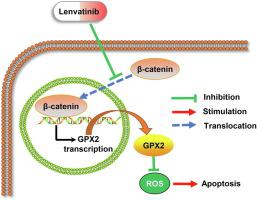Journal of Advanced Research ( IF 10.7 ) Pub Date : 2022-03-21 , DOI: 10.1016/j.jare.2022.03.012 Wenliang Tan 1 , Kelin Zhang 2 , Xinming Chen 3 , Lei Yang 1 , Sicong Zhu 4 , Yingcheng Wei 3 , Zhiqin Xie 1 , Yajin Chen 1 , Changzhen Shang 1

|
Introduction
Lenvatinib has recently become available as the first-line therapy for advanced hepatocellular carcinoma (HCC), but its molecular mechanism in HCC remains largely unknown.
Objectives
The current study aims to identify the molecular mechanisms of lenvatinib in HCC.
Methods
Gene expression microarrays, flow cytometry, western blot, qRT-PCR, immunohistochemistry and immunofluorescence were used to study the response of HCC cells to lenvatinib. Xenograft tumor of Huh7 cells was also established to detect the effect of lenvatinib in vivo.
Results
Herein, we found that lenvatinib could induce apoptosis via increasing reactive oxygen species (ROS) levels in HCC cells. Then, microarray analysis and qRT-PCR results confirmed that GPX2 was a vital target for lenvatinib against HCC. Loss and gain function of experiment showed that regulating GPX2 levels markedly affected the lenvatinib-induced ROS levels and apoptosis in HCC cells. In addition, analyses of The Cancer Genome Atlas database and the qRT-PCR results in our cohort both showed that GPX2 markedly overexpressed in tumor tissues and correlated with poor overall survival in HCC. Mechanistically, our findings further demonstrated that GPX2 was a downstream gene regulated by β-catenin, while lenvatinib could prevent nuclear translocation of β-catenin and further inhibit GPX2 expression in HCC cells. More importantly, the correlation of GPX2 expression with lenvatinib response was further analyzed in 22 HCC patients who received lenvatinib therapy, and the results showed that the objective response rate (ORR) in patients with low GPX2 expression was 44.4% (4/9), while the ORR in patients with high GPX2 levels was only 7.7% (1/13).
Conclusion
Our findings indicated that GPX2 plays an important role in lenvatinib-induced HCC cell apoptosis, which might serve as a biomarker for instruction of lenvatinib therapy in HCC patients.
中文翻译:

GPX2是乐伐替尼抗肝癌诱导细胞凋亡的潜在治疗靶点
介绍
Lenvatinib 最近成为晚期肝细胞癌 (HCC) 的一线治疗药物,但其在 HCC 中的分子机制仍然很大程度上未知。
目标
目前的研究旨在确定乐伐替尼在 HCC 中的分子机制。
方法
基因表达微阵列、流式细胞术、蛋白质印迹、qRT-PCR、免疫组织化学和免疫荧光被用于研究 HCC 细胞对乐伐替尼的反应。还建立了Huh7细胞的异种移植瘤来检测乐伐替尼在体内的作用。
结果
在此,我们发现乐伐替尼可以通过增加 HCC 细胞中的活性氧 (ROS) 水平来诱导细胞凋亡。然后,微阵列分析和 qRT-PCR 结果证实 GPX2 是乐伐替尼抗 HCC 的重要靶标。实验的损失和获得功能表明,调节 GPX2 水平显着影响乐伐替尼诱导的 HCC 细胞 ROS 水平和细胞凋亡。此外,对癌症基因组图谱数据库的分析和我们队列中的 qRT-PCR 结果均表明 GPX2 在肿瘤组织中显着过表达,并且与 HCC 的总生存期较差相关。从机制上讲,我们的研究结果进一步证明 GPX2 是受 β-catenin 调控的下游基因,而 lenvatinib 可以阻止 β-catenin 的核转位并进一步抑制 GPX2 在 HCC 细胞中的表达。更重要的是,
结论
我们的研究结果表明,GPX2 在乐伐替尼诱导的 HCC 细胞凋亡中起重要作用,这可能作为指导乐伐替尼治疗 HCC 患者的生物标志物。



























 京公网安备 11010802027423号
京公网安备 11010802027423号